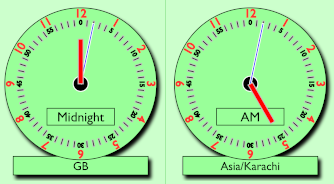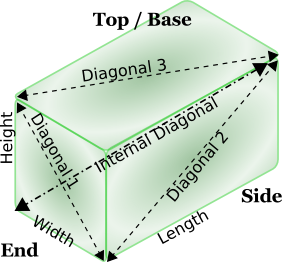CalcResult - Visual Index
Introduction:
This page makes it really easy for you to quickly and efficiently identify and choose which of the calculators on this site is most useful to you, by comparing the diagrams and illustrations that appear alongside most of the calculators on this site.
Dual World-Time Clocks
A pair of world-time clocks offers immense utility, particularly for individuals or businesses operating across different time zones.
By displaying two distinct times simultaneously, this tool simplifies coordination for international calls, virtual meetings, and travel planning, eliminating the mental arithmetic and potential errors of manual conversions.
This dual display is invaluable for maintaining efficient communication with remote teams, family abroad, or tracking global market hours, fostering seamless cross-continental interactions and enhancing productivity by ensuring everyone is on the same metaphorical page, no matter where they are.
Target Archery Stand Designs
Two tried-and-tested designs for professional-quality DIY Target Archery stands are described, along with full construction details, and explanations of the reasons behind the various design decisions. Both designs use low-cost timber, and are easily constructed with minimal tools, but produce stable, functional stands that are better in several ways than A-Frame stands.
Both the "Grove" design and the "Bonnyrigg" design are in use today with Lasswade Archery Club.
Target Archery Rounds
Detailed reference guide to the main, modern target archery rounds as approved by GNAS, FITA, ArcheryGB & World Archery etc. Tables show the number of arrows shot at each distance, the method of scoring used, and the relevant target face style.
Festive Target Archery Faces
Just in time for Christmas shoots, the Sports section now contains a set of Festive Target Archery Faces to print out (preferably A3 size or bigger) for a little extra fun at seasonal archery shoots. Instructions are provided to help you print them as multi-sheet posters so you can have them as large as 'normal' archery target faces. One of the Halloween target faces is shown in use in the photo alongside.
Resistor Colour Bands
This shows the colour codes for a standard resistor, specifically the nearest standard value to the given resistance. The bands define the resistance, and the also the precision / tolerance of the part.
CSS Reference Chart
This shows a summary of the syntax of the current CSS3 specification, as published by the W3C in April 2012. The entries are grouped and coloured based on their attributes, with more info available simply by hovering over the relevant cells.
Resistors in Series
To calculate the total resistance of a network of resistors in series, simply add up all of the individual resistances.
Resistors in Parallel
To calculate the total resistance of a network of resistors in parallel, you should use the Parallel Resistance Calculator.
Inductors in Series
To calculate the total inductance of a network of inductors in series, simply add up all of the individual inductances. This assumes that the inductors are all 'perfect', with no 'mutual inductance' - if the inductors are too close together than their magnetic fields may interfere with one another, invalidating simple calculations.
Inductors in Parallel
To calculate the total inductance of a network of inductors in parallel, you should use the Parallel Inductance Calculator. Note that if the inductors are too close together in a real-world circuit, they may exhibit 'Mutual Inductance' where their magnetic fields interfere, affecting their nominal value.
Capacitors in Series
To calculate the total capacitance of a network of Capacitors in series, you should use the Capacitors in Series Calculator.
Capacitors in Parallel
To calculate the total capacitance of a network of capacitors in parallel, simply add up all of the individual capacitance values.
Charts
Looking to produce a high-quality Pie Chart or Line Graph of your data? Then try out the Statistical Calculator, the Averaging Calculator or the Totalising Calculator with Labels and press the "Draw Pie Chart" or "Draw Line Chart" button, as appropriate.
Electromagnetic-Spectrum Chart
This interactive chart shows the relationships between the different kinds of electromagnetic waves over the entire spectrum, from Radio Waves to Gamma Rays, with detailed expansions of the Visible light, Radio wave and Microwave frequency ranges. It shows both frequency in Hertz, and wavelength in metres.
The Electromagnetic-Spectrum Chart, is just one part of the Reference Information section.
Cuboids: Rectangular objects and Cubes
The rectangular box is one of the commonest shapes in the world, and is really useful for calculating the space available in a room, a box or a Lorry, truck or ISO container. If you know the length, width and height, you can calculate the longest item that will fit in (given by the "Internal Diagonal" also known as the major diagonal. For sheet material, the other diagonals show the maximum sizes that will fit into the same space.
If you want to lay concrete foundations, then enter the appropriate length, width and height/depth, then choose from the "Material" list. Choose "Concrete" to calculate the volume and weight to order, or pick the material that is being removed to know how big a skip to order. If you are laying outline foundations rather than a single slab, then repeat the calculation for each section, and add the results together.
If you are planning a swimming pool, a cold-water tank or a fuel storage tank, then enter the appropriate length, width and height/depth, then choose the appropriate liquid from the "Material" list. For a tank, you may prefer to provide the required volume, two of the three sides, and let this calculator work out the remaining dimension for you, along with the amount of sheet required to form the box, and the weight of the contents.
This Rectangular objects Calculator, can be found in the Maths> 3d_geometry section.
Circle Calculator
Circular designs always require care, as the dimensions are not very intuitive. Despite this, it is often necessary to calculate the size of a circular pond or the area of a semi-circular flower border for a garden.
Given either the radius or diameter of a wheel, this calculator will reveal the distance that the wheel will travel in a single turn, which is essential to working out the correct gear ratio to use.
This Circle Calculator, can be found in the Maths> 2d_geometry section.
Semi-Circle Calculator
Circular designs always require care, as the dimensions are not very intuitive. Despite this, it is often necessary to calculate the size of a semi-circular flower bed, or many other DIY & construction tasks.
This Semi-Circle Calculator, can be found in the Maths> 2d_geometry section.
Ohms Law (Power, Voltage, Current, Resistance) Calculator
A great many problems in Electrical and Electronic engineering come down to the fundamental principles of Power, Voltage, Current & Resistance. Even the tiny dimensions of a modern micro-processor or integrated-circuit based audio player follow Ohm's Law.
This Ohms Law (Power, Voltage, Current, Resistance) Calculator, can be found in the Electronics section.
Chipboard Flooring Calculator
Whether you are planning to lay a floor in a garret, or a shed, or maybe a new conservatory or extension, the commonest choice of material is chipboard, fibreboard or Oriented-Strand Board (OSB).
This calculator makes it easy to get an accurate estimate of how many boards you will need to buy, and the cost, even if the boards are sold as part of a pack, which is particularly common for the smaller sizes that are designed to fit through a loft hatch when flooring an attic.
This Chipboard Flooring Calculator, can be found in the DIY> Flooring section.
Accountant's Calculator
Adding up a set of sale prices, or component costs should be a simple business, but a standard calculator gives no confirmation that everything was entered correctly.
This calculator makes errors a thing of the past: any slip of the fingers is visible not just immediately, but once the calculation is complete, and can be corrected without needing to re-enter the whole list.
The list can then be printed or saved as is, complete with formatting just the way that Accountant's like it.
This Accountant's Calculator, can be found in the Finance section.
Frequency, Wavelength, Period Calculator
Whether it be radio, light, sound or water, waves are all around us. As a result, courses from High School to University or professional qualifications in Physics, Engineering or electronics will frequently include questions on the propagation of waves.
This Frequency, Wavelength, Period Calculator, can be found in the Electronics section.
Calculate Rectangles
Probably the commonest question asked in a DIY store is "How much paint do I need?". If you are going to paint the interior walls of a room, then just enter the length and height of each wall into the calculator, and it will tell you the surface area. Repeat this for each wall, and add up each value to give the total area. Now, enter the width and height of all of the windows and doors, and subtract this from the first figure, to give the required area to be painted. You can now check this result against the coverage figure given on the paint can, but remember to double or treble the area if you expect to use two or three coats of paint. Painting an exterior wall is exactly the same procedure, just remember that masonry paint is usually thicker than emulsion, so check the coverage on the paint can.
When laying carpet or solid flooring, putting up wallpaper or tiles, the initial pricing will almost certainly be quoted 'per square metre' which means that you need to convert the length and width into area, which this calculator can do for you in an instant.
The garden is another major use for this calculator. Whether laying concrete, blocks or slabs, grass or maybe some wooden decking, the pricing will again be quoted 'per square metre' which means that you need to calculate the area with this calculator.
This Rectangle Calculator, can be found in the Maths> 2d_geometry section.



















